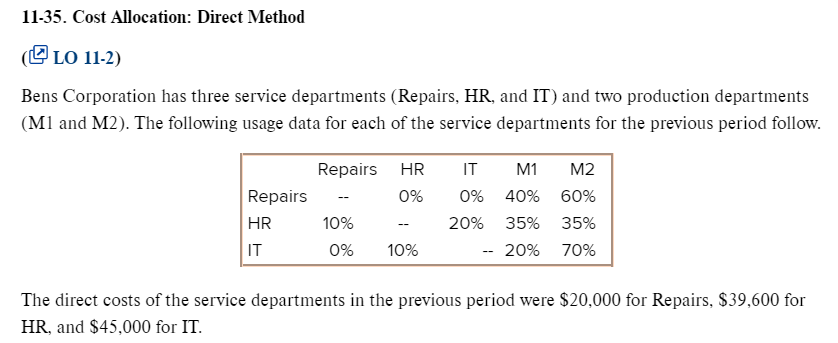
The values added beyond the split-off point are $280,000 for productW and $160,000 for product D. (See the note under the table for these calculations.) These values do not change, regardless of the joint costallocation method, although the individual gross profit amounts vary widely across the four methods. Clearly, selling both white and dark fried chicken ismore profitable than selling either product at the point of separation. The Cutright Company has a small factory with two service departments and two producing departments. The service departments, Power and Maintenance provide support to the producingdepartments, Cutting and Assembly, to each other and also use some of their own services.
Management Accounting: Concepts, Techniques & Controversial Issues

Headcount cost allocation works by dividing costs based on the number of full time employees (FTEs) in each department. In business, this method often suits costs like human resource services or office supplies, where usage typically scales with team size. In this scenario, a department with 30% of the company’s employees would shoulder 30% of these shared expenses. Real estate developers often create multiple project phases, which must be accounted for separately.
FAR CPA Practice Questions: Capital Account Activity in Pass-through Entities
The term allocation” is commonly used in various contexts, such as finance, economics, project management, and resource management. However, it’s essential to understand that allocation ” doesn’t mean “equal distribution” or “uniform distribution” of resources. Determine the difference in the total operating cost if electricity were purchased externally and indicate whether the company should make or buy electricity. Now assume that the actual number of purchase orders completed during the period was 290 for the Cooking Department and 100 for the Canning Department. Also assume that actual costs for purchasing and receiving are $60,000 fixed costs and $39,000 variable costs. Each of these equations includes two unknowns, thus determining S1 and S2 requires solving the equations simultaneously.
Accounting for Managers
The right financial reporting software gives you instant visibility into your costs allowing you to put an accurate and efficient cost allocation plan in place. Managers can track expenditures in real time, spot trends quickly, and adjust cost allocations on the fly. No more waiting for month-end financial reports or wrestling with error-prone Excel spreadsheets. When business conditions change, your cost allocations update automatically. There are many ways to allocate expenses, including the high/low method and step-up/down.
Accurate Product Cost
Put simply, cost allocation is the process of identifying and assigning costs to departments, projects, products or branches in your company. Just like dividing up a shared bill in a restaurant, cost allocation is the process of identifying the costs (and shared expenses) of an organization and assigning them to different parts of the whole. There are two main ways to allocate these service costs to the operating departments to make sure we are including all of the costs when we price our products. Step-down allocation refers to allocating costs from one department to another department or product. This method is used when costs cannot be directly traced to specific products or services.
- A more sophisticated approach would be to allocate the $100,000 based on the regions where the money was spent.
- The allocations based on sales values at the split-off point (See Exhibit 6-17) are more acceptable from both the financial reporting and decision perspectives.
- If a firm produces many different products that consumeindirect resources in different proportions, then a two stage approach is needed to provide accurate product costs.
Role of Cost Allocation in Pricing
Better resource management, more strategic planning, and ultimately, stronger business performance. When you track costs accurately, you see the true cost of each project and product. You understand which business units are using what resources, and can make decisions based on real data rather than guesswork. Teams become accountable for their spending, and you can quickly spot opportunities to reduce waste and improve efficiency.
The allocation comes from the Latin prefix ad- (meaning “to”) and the noun loci (meaning “place”). The combination of these two words implies the idea of assigning a place, or portion of something, for a specific purpose. The word “allocation” comes from the Latin word “allocare.” The word allocation ” refers to setting aside or assigning a particular portion, amount, or portion of something for a specific purpose or recipient. For example, in finance, the allocation of investments must be reviewed regularly to ensure that the portfolio is aligned with the investor’s goals and objectives. OnEntrepreneur is an online magazine centered on business, finance, marketing, technology and more. We are regularly updated – sign up with our newsletter to send the updates directly to your inbox.
For information pertaining to the registration status of 11 Financial, please contact the state securities regulators for those states in which 11 Financial maintains a registration filing. 11 Financial may only transact business in those states in which it is registered, or qualifies for an exemption or exclusion from registration requirements. 11 Financial’s website is limited to the dissemination of general information pertaining to its advisory services, together with access to additional investment-related information, publications, and links. For example, suppose your company produces two products, products A and B.
These can include labor-related costs, machine hours, distribution or admin costs, or anything else that causes a change in the costs of your business activity. When every department what is price variance understands its exact financial impact, they make smarter decisions. Instead of working with rough estimates, teams can optimize their operations based on actual costs.
In today’s competitive business environment, effective cost allocation is crucial for organizations aiming to optimize their resources and enhance profitability. Properly allocating costs ensures that each department or service accurately reflects its financial performance, enabling better decision-making and strategic planning. In summary, cost pools and cost drivers are critical elements of the cost allocation process.






